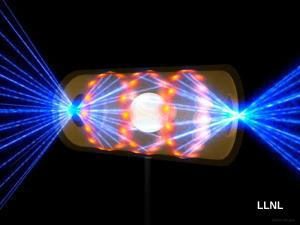Lasers are powerful light beams, capable of shining into the sky or cutting through solid materials. They can be colored or ultraviolet and are the favorite accessory of rock bands and Bond villains alike. They’re also both older yet more recent than people realize: the theory of lasers was first introduced in 1958. But what does that theory entail? In other words, how does a laser work?

Understanding how lasers function is based on having a fundamental knowledge of how atoms create light. When the electrons in an atom begin to absorb energy, they leave their default “stable” state and move further from the nucleus. This is referred to as the “excited” state. An excited electron is no longer stable and tries to return to its normal state. It expels the excess energy in the form of a photon or a “packet” of light. With enough photons, more powerful lights are made.
Because of the power behind lasers, a medium with plenty of electrons is required. For your average red laser, a ruby is used as the medium. There’s also the flash tube or some other way of stimulating the electrons. The tube also holds the laser in place in some cases. The flash tube is connected to an electric energy source, turning it on and off.
When the tube flashes, energy in the form of photons are injected into the crystal. The atoms in the ruby absorb these photons as the electrons jump to a higher energy level. In a process known as “spontaneous emission,” the electrons quickly return to their stable energy level by emitting photons of light in the matter of milliseconds. These photons then travel throughout the crystal at the speed of light. Eventually, the photons stimulate an atom already in its excited state. A new photon is created, and the original photon is returned- a procedure known as “stimulated emission.” Because there are now two photons, the light has been multiplied and amplified. Hence the name “laser“- “Light Amplification by Stimulated Emission of Radiation.”

The photons keep bouncing thanks to a mirror at one end of the crystal. Another partial mirror at the opposite ends keeps some photons trapped but allows others to escape. The ones that escape do so as a concentrated beam of light- the laser beam we all recognize. This all happens in a matter of seconds for smaller lasers, like the ones used in a laser pointer. Larger lasers used for industrial work may take longer to “warm up,” as it were.
As the term “stimulated emission of radiation” implies, radiation does play a part in how lasers work. However, this is not to be confused with radioactivity. While lasers are dangerous if used improperly, they do not set off Geiger counters. Instead, it uses electromagnetic radiation, the same kind used in things like X-rays and microwave ovens. Again, prolonged exposure to any kind of radiation is hazardous, but proper usage will prevent injury or prolonged side effects. (Sorry if you were hoping to become the next Hulk.)
Understanding how lasers operate makes many everyday objects easy to comprehend. Due to the nature of light and the may ways electromagnetic radiation can be emitted, it’s easy to see how lasers can do everything from cut through steel to print out word documents. Lasers can be gentle enough to read a DVD or powerful enough to guide a missile. They’re incredibly versatile and multi-faceted, just as all aspects of science are.

Although it’s safe to say laser tag is not what Theodore Maiman had in mind when he built the first working laser. But he probably wouldn’t complain about it, either.
Follow our World of Production, where big ideas bring big growth.







